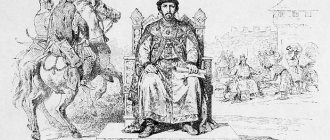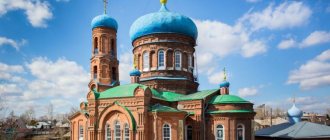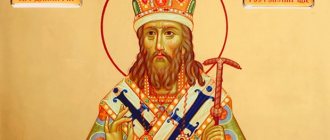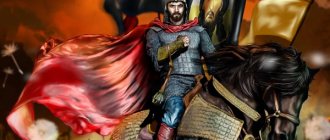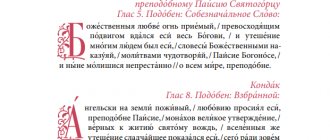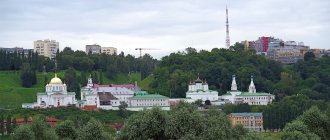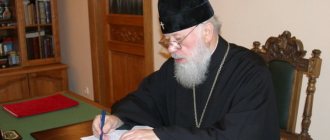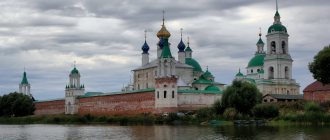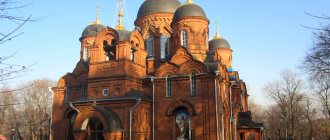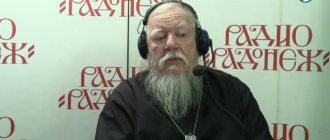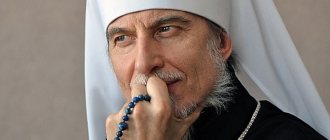№10 (619) / March 7 '11
Diocese
A little history
Established at the Moscow Council by Patriarch Filaret and his royal son Mikhail Fedorovich in September 1620. The first Orthodox diocese in Siberia. In 1667, at the Great Moscow Council, a metropolitanate was established in Tobolsk, as the diocese grew, becoming the most extensive in the then Russian Church. Until the second half of the 18th century, the Tobolsk diocese, which coincided with the administrative borders of the Siberian province, included the territory of the Urals, Siberia and the Far East.
In the 19th century, the network of educational institutions in the diocese was significantly expanded, and literature was published in the national languages of the peoples of Siberia.
After 1917, the diocese was subjected to severe persecution, dividing the share of the entire Russian Orthodox Church under the yoke of atheistic power. Since 1937, a campaign of mass closure of churches, arrests and executions of the clergy began. From 1937 to 1942, not a single Ruling Bishop remained on the territory of Siberia, which is why all Siberian dioceses ceased to exist; but during these years, St. Luke (Voino-Yasenetsky), the only bishop in Siberia who could perform the sacraments, lived in exile in the Krasnoyarsk Territory. Therefore, in the diptych of the archpastors of the Tobolsk and Omsk dioceses, Archbishop Luke is indicated as the Ruling Bishop of this period.
At the end of the Great Patriotic War, several churches were opened in the cities of the south of the region, and the territory of the former Tobolsk diocese was included in the Omsk-Tyumen diocese formed in 1947. Until the end of the 1980s, only 8 churches functioned in the vast Tyumen region.
Names of the diocese in different years:
Siberian and Tobolsk (1620 - October 5, 1768). Tobolsk and Siberian (October 5, 1768 – 1937). Tobolsk and Tyumen (since 1990). Address: 626152, Tyumen region, Tobolsk, Red Square, Kremlin. Phone: Fax: E-mail: Ruling Bishop: Archbishop of Tobolsk and Tyumen Dimitry
Archbishop of Tobolsk and Tyumen Dimitry
Date of birth: March 11, 1952 Date of consecration: November 4, 1990 Date of tonsure: January 31, 1986 Angel Day: February 24.
Biography. Born in the village. Udelnoye of Ramensky district, Moscow region. in a working-class family.
In 1974 he graduated from the Moscow Institute of Transport Engineers and worked as a designer.
In 1984 he graduated from the Moscow Theological Seminary, in 1987 – from the Moscow Theological Academy with a candidate of theology degree.
On January 31, 1986, in the Trinity-Sergius Lavra, he took monastic vows, on February 23, he was ordained a hierodeacon, and on April 7, a hieromonk. In November 1986, after a fire in the Trinity-Sergius Lavra, he was appointed economist of the Lavra and Moscow Theological Schools for the period of restoration work.
On March 25, 1987 he was elevated to the rank of hegumen, on June 13 - to the rank of archimandrite with the appointment of deputy rector of the Moscow Academy of Sciences and Sports for administrative and economic work. Since April 20, 1989, MDS inspector.
On November 4, 1990, in the Epiphany Cathedral in Moscow, he was consecrated Bishop of Tobolsk and Tyumen. Appointed rector of Tobolsk Theological Seminary. He teaches Old Testament, moral and pastoral theology, and organization of parish life at the seminary.
Since February 26, 1994, member of the Synodal Theological Commission.
In 1999 he was elevated to the rank of archbishop.
Education: 1974 – Moscow Institute of Transport Engineers. 1984 – Moscow Theological Seminary. 1987 – Moscow Theological Academy.
Church awards: Order of St. Equal Apostles. Book Vladimir III degree; Order of St. Sergius of Radonezh II degree; Order of St. Innocent, Met. Moscow and Kolomenskoye, II degree; Venerable Medal Sergius of Radonezh II degree; cross of St. Apostle and Evangelist Mark II degree, Alexandrian Orthodox Church.
His Holiness Patriarch Kirill of Moscow and All Rus' congratulated Archbishop Dimitry of Tobolsk and Tyumen on his 25th anniversary of service in the priesthood
His Eminence, Most Reverend Dimitri, Archbishop of Tobolsk and Tyumen
Your Eminence!
I cordially congratulate you on your 25th anniversary of service in the priesthood.
A quarter of a century ago, in the Holy Trinity Lavra of St. Sergius, by the laying on of hands of the bishops, you were called to serve on earth, but according to the heavenly order (St. John Chrysostom).
It is gratifying that you pay special attention to spiritual education, continuing the traditions of the first educators of Siberia. Through your care, a young generation of clergy is being educated in the Tobolsk seminary and school, and in the gymnasiums of the diocese, children are taught the fundamentals of the Orthodox faith. Today you are managing to solve the difficult but important task of providing pastoral care to the population of the Far North.
Through the prayers of St. John of Tobolsk, all the Siberian saints and your heavenly patron, St. Demetrius of Prilutsk, may the Lord Almighty pour out His abundant mercies on you and strengthen you in your further archpastoral labors for many and prosperous years.
With love in Christ,
KIRILL, PATRIARCH OF MOSCOW AND ALL Rus'
Tobolsk Theological Seminary
In 1703, in Tobolsk, the ancient capital of Siberia, by decree of Tsar Peter I, Metropolitan Philofey (Leshchinsky) opened the first educational institution beyond the Urals - a Slavic-Russian school. In 1743, the school was transformed into the Tobolsk Theological Seminary, which is the oldest educational institution in Siberia.
The seminary is a higher theological educational institution of the Russian Orthodox Church, training clergy, as well as clergy and church specialists (state license No. 16-579). The seminary implements the “Church educational standard for higher spiritual education of a specialist in the field of Orthodox theology” (adopted by the Holy Synod of the Russian Orthodox Church, magazine No. 71 of 08/21/2007)
In four departments of the seminary (theology, biblical studies, church history, church-practical) they study biblical history, the Holy Scriptures of the Old and New Testaments, the history of Russia and the Russian Orthodox Church, theological sciences, liturgy (the science of Orthodox worship), patrolology (the science of life and the works of the Holy Fathers), homiletics (the art of church preaching), church singing, ancient and modern foreign languages and other humanitarian subjects. Duration of training – 5 years. In addition to their studies, seminary students carry out extensive missionary and educational work and participate in pilgrimage trips throughout Russia and abroad. At the theological school, the student magazine “Seminary” is published by students.
Every year, youth congresses, regional and regional scientific and practical conferences, seminars, round tables, festivals, competitions and other events are held on the basis of the Tobolsk Theological Seminary.
During the school spring holidays, the theological school holds an Open Day, when everyone can get acquainted with the history of the seminary, the educational and educational process in the theological school.
TELEPHONES Rector of the Tobolsk Orthodox Theological Seminary - (3456) 09/22/13. Vice Rector for Academic Affairs -. Vice-rector for educational work -.
REGENCY SCHOOL The Regency School, opened at the seminary in 1991, trains regents (conductors) of church choirs, psalmists (readers) and singers, and Sunday school catechists. At the Regency School they study theological and historical subjects, church singing, the Church Rules, as well as musical subjects: solfeggio, harmony, choral arrangement, conducting. Duration of training – 3 years.
Telephone:
ICON-PAINTING SCHOOL The icon-painting school was opened at the seminary in 1996. The school trains icon painters, restorers, and specialists in the field of church art. In the icon painting school they study biblical history, the history of the Russian Orthodox Church, art history, iconography, icon painting and other subjects. Duration of training – 5 years.
Education, accommodation and meals at Tobolsk Theological schools are free. Seminary students receive a scholarship.
Telephone:
HEAVENLY PATRONS St. John, St. Philotheus, Hieromartyr Hermogenes.
The shrine of the diocese of Abalakskaya Icon of the Mother of God “The Sign”
During the reign of Mikhail Fedorovich, in 1636, under the third Siberian Archbishop Nektary, a poor, lonely and childless widow named Maria lived in the Abalak churchyard. She led a pious and chaste life. In a light dream, she saw three icons in the air. In the middle is the icon of the Mother of God, to the right of it is St. Nicholas, and to the left is the Venerable Mary of Egypt. There was a voice from the icon of the Mother of God: “Mary! Announce this vision to the people and tell them to build on the right side of the dilapidated Church of the Transfiguration a new, wooden one in the Abalaksky churchyard, in honor of the icon of the “Sign” of the Most Pure Mother of God, which is in distant Novgorod, with chapels: on one side - St. Nicholas, and on the other - Venerable Mary of Egypt."
Enlightened by this vision, the widow went to Archbishop Nektarios and told him in front of the whole council about the visions, after which she told all the people about her revelations. When Mary was shown the image of the “Sign” of the Mother of God, which she had never seen, she, looking at the icon, recognized in it the Mother of God who had appeared to her and announced to everyone that it was this image that she had seen in all four visions. All citizens believed Mary's story. His Grace the Archpastor gave the Abalak parishioners the blessing to build a church in the name of the Mother of God. Many citizens of Tobolsk agreed to take part in this charitable deed.
At this time, one peasant, Evfimy, was lying relaxed. A beggar named Pavel came to him and said: “Euphemius! In Abalak, by order of God, a church is being built in honor of the “Sign” of the Mother of God, St. Nicholas and St. Mary of Egypt. Make a promise to paint a temple image for this church. Perhaps the Lord, through your faith and zeal, will forgive you and free you from your illness.”
As an angel of God, Euthymius listened to Paul and then made a vow to paint an icon. The Lord listened to the labors of the sufferer. In the afternoon of the same day, Euthymius began to control the right side of his body. Having asked for the blessing of the Most Reverend Nektarios, Euthymius ordered the image indicated to him from Protodeacon of the Sophia Cathedral of Tobolsk Matthew, who was then famous throughout Siberia as a most skillful painter.
As the icon was painted, Euthymius felt better day by day. Finally his health completely improved. He came to the painter and himself took the painted image from him to the cathedral for consecration.
The surprised and delighted Archpastor thanked the Lord for His miraculous help to the sick man. Having sprinkled the image with holy water, he served a prayer service in the cathedral, after which with great honor he conveyed the icon to Abalak to place it in the new church.
When the icon was transferred and the church procession reached the village of Shantalyk, the Mother of God glorified Her image with a new miracle. The peasant of this village, Vasily, had a daughter who had suffered from an eye disease for a long time and had not seen anything for two years. Hearing that they were carrying the image to Abalak, Vasily went out with his unfortunate daughter to meet the procession. Having fallen to the image with faith and tears, the grieving father begged the Most Pure Virgin to have mercy on his unfortunate daughter, and, to the joy and surprise of him and all those present, the girl regained her sight.
From that time on, the people’s faith in the Abalak image of the Mother of God was established as truly miraculous and providing various healings of illnesses to all those who come to it with faith. The special significance at that time of Tobolsk, which honored the holy icon, conveyed reverence for it throughout Siberia.
In 1918, fearing for the miraculous icon of the Mother of God, Bishop Methodius and Admiral A.V. Kolchak takes away the icon from the monastery on a boat. Until recently, her whereabouts were unknown. There were many legends about its existence abroad. Only almost 80 years later did the location of the icon become known - the Australian city of Sydney, the Church of the Intercession of the Mother of God. She was brought here by White Army General Mikhail Konstantinovich Diterichs (1874-1937).
Currently, in the Znamenskaya Church of the Abalak Monastery, instead of the original icon, there is a miraculous copy of the Abalak Icon of the Mother of God, written at the beginning of the 20th century by the nun Augusta of the St. John the Vvedensky Monastery.
The tradition of holding a religious procession began with an event that occurred in 1665, when it rained continuously for almost the entire summer; bread, vegetables and grass died - everything was drowned with water, and the people fell into despair from the expectation of starvation. In this misfortune they turned to the Mother of God. Archbishop Korniliy, who was at the Tobolsk See at that time, sent a council of clergy to the village of Abalakskoye for the miraculous icon of the Mother of God. The shrine was taken out with due honor on July 7, and the next day in the morning they were brought to Tobolsk.
The archbishop with the city clergy, accompanied by the mayors and many people, went out to meet the Queen of Heaven. And when those carrying the icon approached, the Archpastor fell to the ground and said: “O Lady of the world! Have mercy on this city and the people who have sinned against You, and beg Your Son and our God to deliver us now from His righteous wrath,” he kissed the icon. Having performed a prayer service, we went with the icon to the cathedral, where they began to celebrate the Divine Liturgy. The service had not yet ended when, to the surprise and joy of everyone, the darkness cleared, the rain stopped, the clouds disappeared, and the sun appeared. In memory of this event, for eternal thanksgiving to the Lord God and His Most Pure Mother, His Grace Cornelius established the bringing of the miraculous icon of the Mother of God from Abalak to Tobolsk annually. Since then, a tradition has been established to move the icon to Tobolsk every year on the day of the Great Martyr Procopius, i.e. by July 8, old style. The shrine stood in the cathedral until July 20, i.e. before the feast of the prophet Elijah. This went on for more than 250 years.
In 1999, it was decided to revive the ancient tradition of the religious procession on Siberian soil. On July 20, Sunday, the first religious procession took place after a long interval.
The celebration of the icon takes place on August 2 (July 20, old style) and December 10 (November 27, old style). In honor of the icon, the Abalak monastery was founded by Saint Varlaam in 1783.
Holy Dioceses
- Saint John (Maximovich), Metropolitan of Tobolsk
- Saint Philotheus (Leshchinsky), Metropolitan of Tobolsk
- Hieromartyr Hermogenes (Dolganov), Bishop of Tobolsk
- Holy Martyr Theodore of Tobolsk
- Venerable Misail of Abalak
- Saint Paul, Metropolitan of Tobolsk and All Siberia
- Saint Varlaam (Petrov), Archbishop of Tobolsk
Educational establishments
- Tobolsk Orthodox Theological Seminary.
- Tyumen Orthodox Theological School.
As of September 2009, the diocese operated 14 Orthodox secondary schools in Tyumen, Tobolsk, Ishim, Khanty-Mansiysk, Surgut, Nefteyugansk, Nizhnevartovsk, Megion, Langepas, Yugorsk, Noyabrsk, Novy Urengoy, Yalutorovsk, Salekhard. At the stage of opening Orthodox gymnasiums in the cities of Raduzhny and Nadym.
Monasteries of the diocese
- Holy Sign men's. 626125, Tyumen region, Tobolsk district, village. Abalak.
- Holy Trinity men's. 625001, Tyumen, st. Kommunisticheskaya, 10. Viceroy – Archimandrite Tikhon (Bobov).
- Ioanno-Vvedensky Women's. 626123, Tyumen region, Tobolsk district, pos. Priirtyshsky, st. Redikultseva, 5. Tel..
- Mother of God-Nativity Iliinsky Women's. 625002, Tyumen, st. 25 years of October, no. 29; tel., 46-16-60, 46-75-45; Fax. The abbess is nun Nina (Skhulukhia).
Orthodox associations and organizations
- Interregional public movement “Young Orthodox Siberia”;
- "Orthodox Siberia";
- Missionary Brotherhood of the Holy Martyr. Demetrius of Thessalonica at the Missionary Department.
Mass media
Printed publications:
- "Siberian Orthodox Newspaper" (monthly publication);
- magazine “Orthodox Enlightener” (published six times a year);
- children's magazine “Orthodox Siberian” (published three times a year);
- student Orthodox magazine “Seminary” (published twice a year).
Websites:
- Tobolsk-Tyumen diocese - https://www.tobolsk-eparhia.ru;
- Church of the Holy Rule Simeon of Verkhotursky (Ugra deanery) – https://simeon.prihod.ru;
- Church of St. Nicholas (Tyumen) – https://hram.mt72.ru;
- Church of the Archangel Michael (village Chervishevo) – https://www.chervishevo-hram.ru;
- Church of All Saints, in the Russian Land of the Shining Ones (Tyumen) - https://vsehsvyatyh.orthodox.ru;
- “Orthodox churches of the Khanty-Mansi Autonomous Okrug” - https://www.hramhmao.orthodoxy.ru.
Website of the Tobolsk and Tyumen diocese: www.tobolsk-eparhia.ru
In other rooms:
Awards
- Order of the Holy Blessed Prince Daniel of Moscow, II degree[4]
- Order of St. Sergius of Radonezh, II degree
- Order of the Holy Venerable Seraphim of Sarov, II degree
- Order of St. Innocent, Metropolitan of Moscow and Kolomna, II degree
- Order of the Holy Equal-to-the-Apostles Grand Duke Vladimir, III degree
- Medal of St. Sergius of Radonezh, II degree
- Cross of the Holy Apostle and Evangelist Mark, II degree (Alexandrian Orthodox Church)
- Cross of St. Apostle Paul (Hellenic Orthodox Church)
- Order of St. Cyril of Turov, II degree (Belarusian Exarchate of the Russian Orthodox Church)
Notes
- [mospat.ru/archive/1999/03/nr903021/ Patriarchal awards: Russian Orthodox Church]
- Kapalin, Alexey Mikhailovich. [www.tmnlib.ru/DbFileHandler.axd?2077 Social functions of the Institute of the Russian Orthodox Church]: abstract of thesis. ... candidate of sociological sciences: 22.00.04 / Kapalin Alexey Mikhailovich; [Place of protection: Tyumen. state University]. - Tyumen, 2009. - 26 p.
- [www.patriarchia.ru/db/text/3289826.html On the day of the repose of St. Sergius of Radonezh, His Holiness Patriarch Kirill led the patronal celebrations in the Trinity-Sergius Lavra]
- [www.patriarchia.ru/db/text/2351737.html His Holiness Patriarch Kirill awarded a number of bishops celebrating anniversaries with high church awards]
Excerpt characterizing Dimitri (Kapalin)
Platon Karataev was for all the other prisoners the most ordinary soldier; his name was Falcon or Platosha, they mocked him good-naturedly and sent him for parcels. But for Pierre, as he presented himself on the first night, an incomprehensible, round and eternal personification of the spirit of simplicity and truth, that is how he remained forever. Platon Karataev knew nothing by heart except his prayer. When he gave his speeches, he, starting them, seemed not to know how he would end them. When Pierre, sometimes amazed at the meaning of his speech, asked him to repeat what he had said, Plato could not remember what he had said a minute ago - just as he could not tell Pierre his favorite song in words. It said: “darling, little birch and I feel sick,” but the words didn’t make any sense. He did not understand and could not understand the meaning of words taken separately from speech. His every word and every action was a manifestation of an activity unknown to him, which was his life. But his life, as he himself looked at it, had no meaning as a separate life. She made sense only as a part of the whole, which he constantly felt. His words and actions poured out of him as uniformly, necessarily, and directly as a scent is released from a flower. He could not understand either the price or the meaning of a single action or word. Having received news from Nicholas that her brother was with the Rostovs in Yaroslavl, Princess Marya, despite her aunt’s dissuasions, immediately got ready to go, and not only alone, but with her nephew. Whether it was difficult, not difficult, possible or impossible, she did not ask and did not want to know: her duty was not only to be near her perhaps dying brother, but also to do everything possible to bring him her son, and she stood up drive. If Prince Andrei himself did not notify her, then Princess Marya explained it either by the fact that he was too weak to write, or by the fact that he considered this long journey too difficult and dangerous for her and for his son. Within a few days, Princess Marya got ready to travel. Her crews consisted of a huge princely carriage, in which she arrived in Voronezh, a britzka and a cart. Traveling with her were M lle Bourienne, Nikolushka and her tutor, an old nanny, three girls, Tikhon, a young footman and a haiduk, whom her aunt had sent with her. It was impossible to even think about going the usual route to Moscow, and therefore the roundabout route that Princess Marya had to take: to Lipetsk, Ryazan, Vladimir, Shuya, was very long, due to the lack of post horses everywhere, very difficult and near Ryazan, where, as they said the French were showing up, even dangerous. During this difficult journey, M lle Bourienne, Desalles and Princess Mary's servants were surprised by her fortitude and activity. She went to bed later than everyone else, got up earlier than everyone else, and no difficulties could stop her. Thanks to her activity and energy, which excited her companions, by the end of the second week they were approaching Yaroslavl. During her recent stay in Voronezh, Princess Marya experienced the best happiness of her life. Her love for Rostov no longer tormented or worried her. This love filled her entire soul, became an inseparable part of herself, and she no longer fought against it. Lately, Princess Marya became convinced—although she never clearly told herself this in words—she became convinced that she was loved and loved. She was convinced of this during her last meeting with Nikolai, when he came to announce to her that her brother was with the Rostovs. Nicholas did not hint in a single word that now (if Prince Andrei recovered) the previous relationship between him and Natasha could be resumed, but Princess Marya saw from his face that he knew and thought this. And, despite the fact that his attitude towards her - cautious, tender and loving - not only did not change, but he seemed to rejoice in the fact that now the kinship between him and Princess Marya allowed him to more freely express his friendship and love to her, as he sometimes thought Princess Marya. Princess Marya knew that she loved for the first and last time in her life, and felt that she was loved, and was happy and calm in this regard. But this happiness on one side of her soul not only did not prevent her from feeling grief for her brother with all her might, but, on the contrary, this peace of mind in one respect gave her a greater opportunity to fully surrender to her feelings for her brother. This feeling was so strong in the first minute of leaving Voronezh that those accompanying her were sure, looking at her exhausted, desperate face, that she would certainly get sick on the way; but it was precisely the difficulties and worries of the journey, which Princess Marya took on with such activity, that saved her for a time from her grief and gave her strength. As always happens during a trip, Princess Marya thought only about one journey, forgetting what was its goal. But, approaching Yaroslavl, when what could lie ahead of her was revealed again, and not many days later, but this evening, Princess Marya’s excitement reached its extreme limits. When the guide sent ahead to find out in Yaroslavl where the Rostovs were standing and in what position Prince Andrei was, met a large carriage entering at the gate, he was horrified when he saw the terribly pale face of the princess, which leaned out of the window. “I found out everything, your Excellency: the Rostov men are standing on the square, in the house of the merchant Bronnikov.” “Not far away, just above the Volga,” said the hayduk. Princess Marya looked fearfully and questioningly at his face, not understanding what he was telling her, not understanding why he did not answer the main question: what about brother? M lle Bourienne asked this question for Princess Marya. - What about the prince? – she asked. “Their Lordships are standing with them in the same house.” “So he is alive,” thought the princess and quietly asked: what is he? “People said they were all in the same situation.” What did “everything in the same position” mean, the princess did not ask and only briefly, glancing imperceptibly at the seven-year-old Nikolushka, who was sitting in front of her and rejoicing at the city, lowered her head and did not raise it until the heavy carriage, rattling, shaking and swaying, did not stop somewhere. The folding steps rattled.
